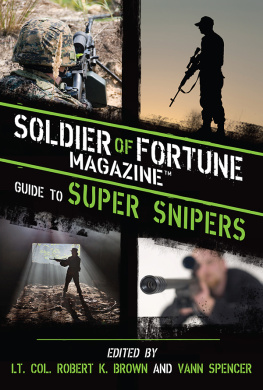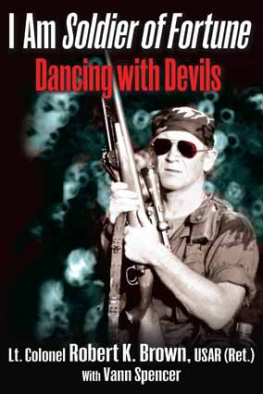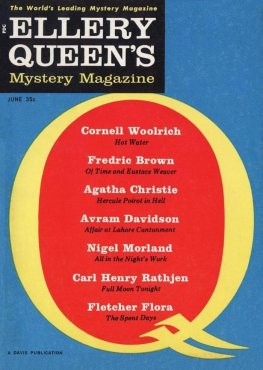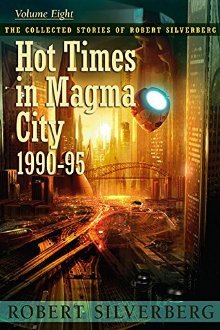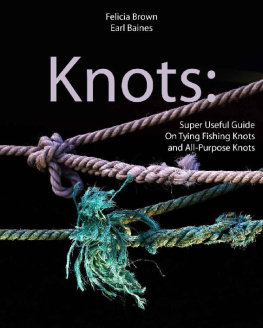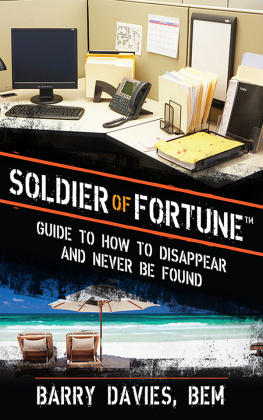Robert K. Brown - Soldier of Fortune Magazine Guide to Super Snipers
Here you can read online Robert K. Brown - Soldier of Fortune Magazine Guide to Super Snipers full text of the book (entire story) in english for free. Download pdf and epub, get meaning, cover and reviews about this ebook. year: 2012, publisher: Skyhorse Publishing (Perseus), genre: Non-fiction. Description of the work, (preface) as well as reviews are available. Best literature library LitArk.com created for fans of good reading and offers a wide selection of genres:
Romance novel
Science fiction
Adventure
Detective
Science
History
Home and family
Prose
Art
Politics
Computer
Non-fiction
Religion
Business
Children
Humor
Choose a favorite category and find really read worthwhile books. Enjoy immersion in the world of imagination, feel the emotions of the characters or learn something new for yourself, make an fascinating discovery.
- Book:Soldier of Fortune Magazine Guide to Super Snipers
- Author:
- Publisher:Skyhorse Publishing (Perseus)
- Genre:
- Year:2012
- Rating:3 / 5
- Favourites:Add to favourites
- Your mark:
- 60
- 1
- 2
- 3
- 4
- 5
Soldier of Fortune Magazine Guide to Super Snipers: summary, description and annotation
We offer to read an annotation, description, summary or preface (depends on what the author of the book "Soldier of Fortune Magazine Guide to Super Snipers" wrote himself). If you haven't found the necessary information about the book — write in the comments, we will try to find it.
Soldier of Fortune Magazine Guide to Super Snipers — read online for free the complete book (whole text) full work
Below is the text of the book, divided by pages. System saving the place of the last page read, allows you to conveniently read the book "Soldier of Fortune Magazine Guide to Super Snipers" online for free, without having to search again every time where you left off. Put a bookmark, and you can go to the page where you finished reading at any time.
Font size:
Interval:
Bookmark:
MAGAZINE GUIDE TO
SUPER SNIPERS
MAGAZINE GUIDE TO
SUPER SNIPERS
EDITED BY
LT. COL. ROBERT K. BROWN, USAR (RET.)
AND VANN SPENCER

Skyhorse Publishing
Copyright 2013 by Lt. Col. Robert K. Brown, USAR (RET.) and Vann Spencer
-All Rights Reserved. No part of this book may be reproduced in any manner without the express written consent of the publisher, except in the case of brief excerpts in critical reviews or articles. All inquiries should be addressed to Skyhorse Publishing, 307 West 36th Street, 11th Floor, New York, NY 10018.
Skyhorse Publishing books may be purchased in bulk at special discounts for sales promotion, corporate gifts, fund-raising, or educational purposes. Special editions can also be created to specifications. For details, contact the Special Sales Department, Skyhorse Publishing, 307 West 36th Street, 11th Floor, New York, NY 10018 or info@skyhorsepublishing.com.
Skyhorse and Skyhorse Publishing are registered trademarks of Skyhorse Publishing, Inc., a Delaware corporation.
Visit our website at www.skyhorsepublishing.com.
10 9 8 7 6 5 4 3 2 1
Library of Congress Cataloging-in-Publication Data is available on file.
ISBN: 978-1-62873-541-3
Printed in China
To All Snipers


As the acknowledged number one military magazine among troops and law enforcement personnel, Soldier of Fortune has supported active duty soldiers and veterans for the last thirty-eight years. In so doing, it has published a multitude of articlesmany of which are included in this anthologyon sniping from shortly before WWII to the present. The material is something that will be of interest to long-range shooters, snipers, and military buffs.
My sniper credentials are limited, since I never completed an Army sniper school. And, frankly, I dont know that I would have done so successfully, as I do not have the patience that is required of a sniper.
My first exposure to sniping came when I was assigned to be the Officer-in-Charge of the 11th Airborne Corps Advanced Marksmanship Unit (AMU) for six months prior to my reassignment to Vietnam in July of l968. The Army actually paid me for shooting! What incredible good fortune.
In that position, I interfaced quite often with personnel from the All-Army AMU, Ft. Benning, Georgia, which was putting together the first Army sniper team that would go to Nam, commanded by Major Willie Powell. That sniper team provided the cadre for the Army sniper school in Nam. During those six months, I oversaw the training of sniper units for the North Carolina National Guard, as well as Fort Bragg.
Sniping, as a critical military skill, had been consigned to the dustbin of history by all the brass smart-asses who pompously proclaimed airpower and firepower would do away with the need for skilled riflemen after the Korean War. Major Powell had a problem in convincing company commanders that a school-trained sniper was a force multiplier; that because a graduate of the sniper school had six months combat time, they could effectively read a map (no GPS in those days), call in airpower and artillery, and was too valuable an asset to be a squad leader or charge bunkers. This problem continues even today, though to a lesser degree.
In any event, Powells success as well as that of Major Jim Land, USMC, who was the commanding officer of the famous Marine sniper, Carlos Hathcock, guaranteed sniping would be an effective tool in future conflicts. And so it has been.
SOFs direct involvement in sniper training occurred in El Salvador, when I took numerous teams of mostly Vietnam veterans to assist/advise the Salvadoran military in their war against communist guerrillas during the 1980s. SOFs brilliant, long-time Small Arms Editor, Peter Kokalis, spent a number of tours training Salvo Police and Jack Thompson, who was a Marine Nam vet, a Sergeant Major in the Rhodesian Selous Scouts and Central American contractor, conducted sniper courses for several Salvadoran Brigades, which resulted in numerous kills.
I got involved in a small way. One time, when a lull occurred in the fighting, I noted that the army units and the guerrillas stood up and yelled insults at each other about 450 yards apart. I decided I could bring some heat on the bad boys with a top-of-the-line sniper system that would reach out and touch them up to several hundred yards. Jim Leatherwoods brother, Jack, took a Winchester Model 70 action, tuned it, added a heavy Schillen barrel, and topped it off with a Leatherwood ART scope. I was hitting metal silhouette targets at Jims Texas ranch at 1,400 meters. Unfortunately, the only time I got to draw down on guerillas, they were running through a coffee plantation. Didnt hit anyone, but I figured I made them run a tad faster.
In closing, I want to talk about Chris Kyle, one of the many participant snipers who was looking forward to being included in Soldier of Fortune Magazine Guide to Super Snipers. I only met Chris once at the 2012 Shooting, Hunting, and Outdoor Trade Show in Vegas, where he was promoting a vendors product. I had a copy of his book, American Sniper: The Autobiography of the Most Lethal Sniper in U.S. Military History, and asked him to autograph it, which he kindly did. It reads:
SOF,
Thank you for all your great articles. You actually peaked my interest to join the military.
Chris Kyle
Others included in the book expressed similar sentiments. And, therefore, I take incredible pleasure in realizing SOF indirectly helped send scores of terrorists to Hell.
Lt. Col. Robert K. Brown, USAR, (Ret.)
SECTION ONE:
YESTERDAYS SNIPERS

The true sniper is not actually, in one sense of the term, a real soldier. His nature, job, and gifts are too individualistic.
Ion L. Idriess
These words were written nearly one hundred years ago and are still applicable today.
Unfortunately, individualism in and of itself flies in the face of contemporary military thinking; for numerous reasons, many commanding officers simply do not understand the huge force multiplier they have with their sniper teams.

U.S. Army Spc. Jason Peacock, a rifleman from Alpha Troop, 1st Squadron, 14th Cavalry Regiment, scans the rooftops from his overwatch position during a cordon and search mission in Baghdad, Iraq, 8 Feb. 2007. The A-1/14th CAV conducted cordon and search missions with 2nd Battalion, 1st Brigade, 6th Iraqi National Police, to maintain security and stability in Baghdad. (U.S. Army photo by Staff Sgt. Sean A. Foley)
The worth of the sniper in warfare has been proven time and again, but these lessons have been largely forgotten after every conflict. That is, until the newest tyrant attempts to rule the world by force and well-trained and equipped snipers are urgently needed once again. This unfortunate cycle of being caught with our pants down results in stop-gap measures like the designated marksman program, issuing worn out M14 rifles for precision work, and pressuring sniper schools to push students through to get enough trained snipers in the field.
Font size:
Interval:
Bookmark:
Similar books «Soldier of Fortune Magazine Guide to Super Snipers»
Look at similar books to Soldier of Fortune Magazine Guide to Super Snipers. We have selected literature similar in name and meaning in the hope of providing readers with more options to find new, interesting, not yet read works.
Discussion, reviews of the book Soldier of Fortune Magazine Guide to Super Snipers and just readers' own opinions. Leave your comments, write what you think about the work, its meaning or the main characters. Specify what exactly you liked and what you didn't like, and why you think so.

